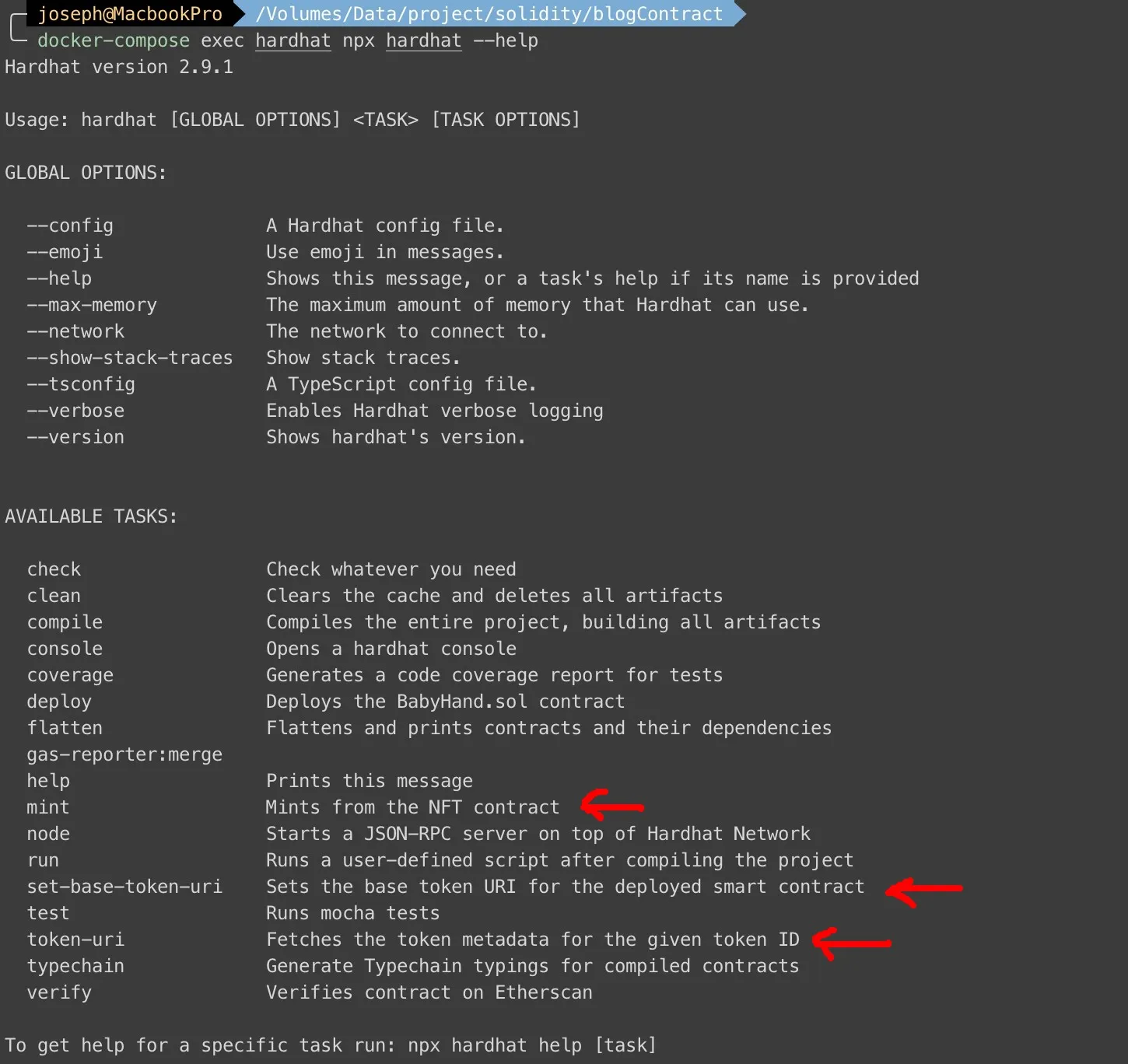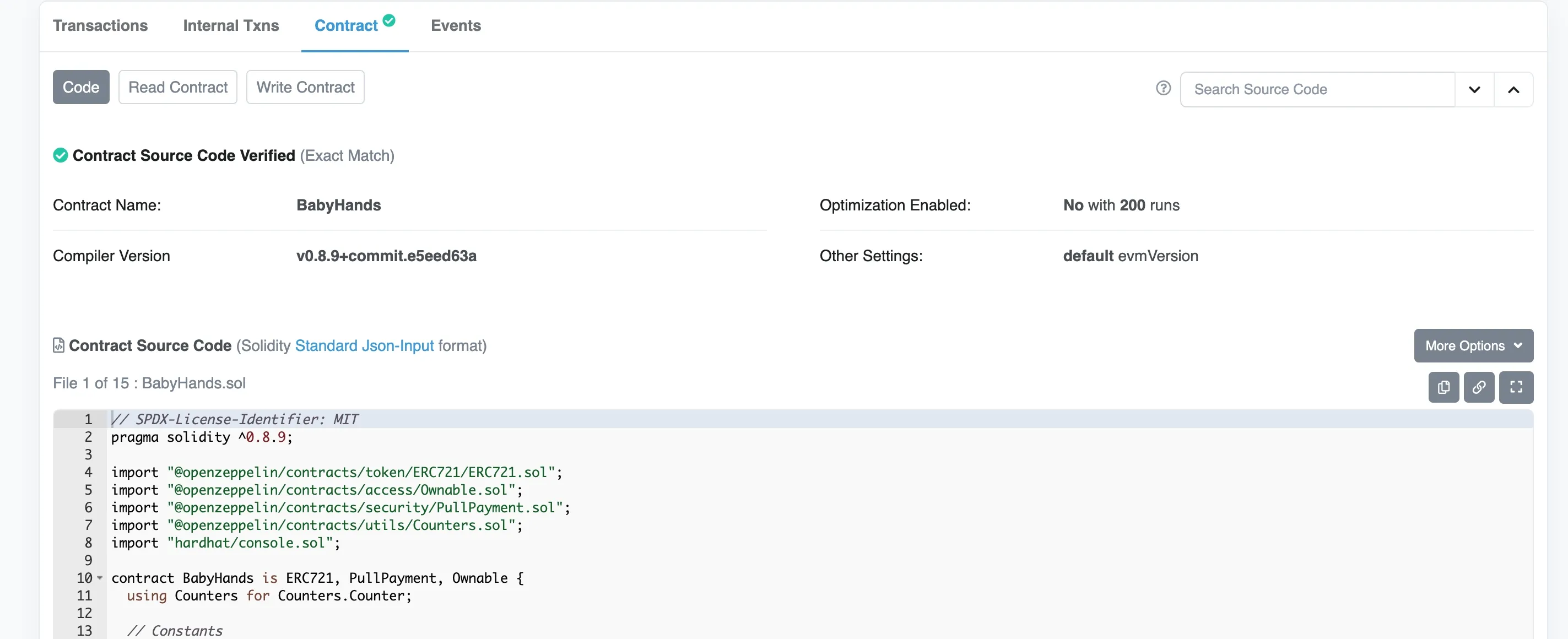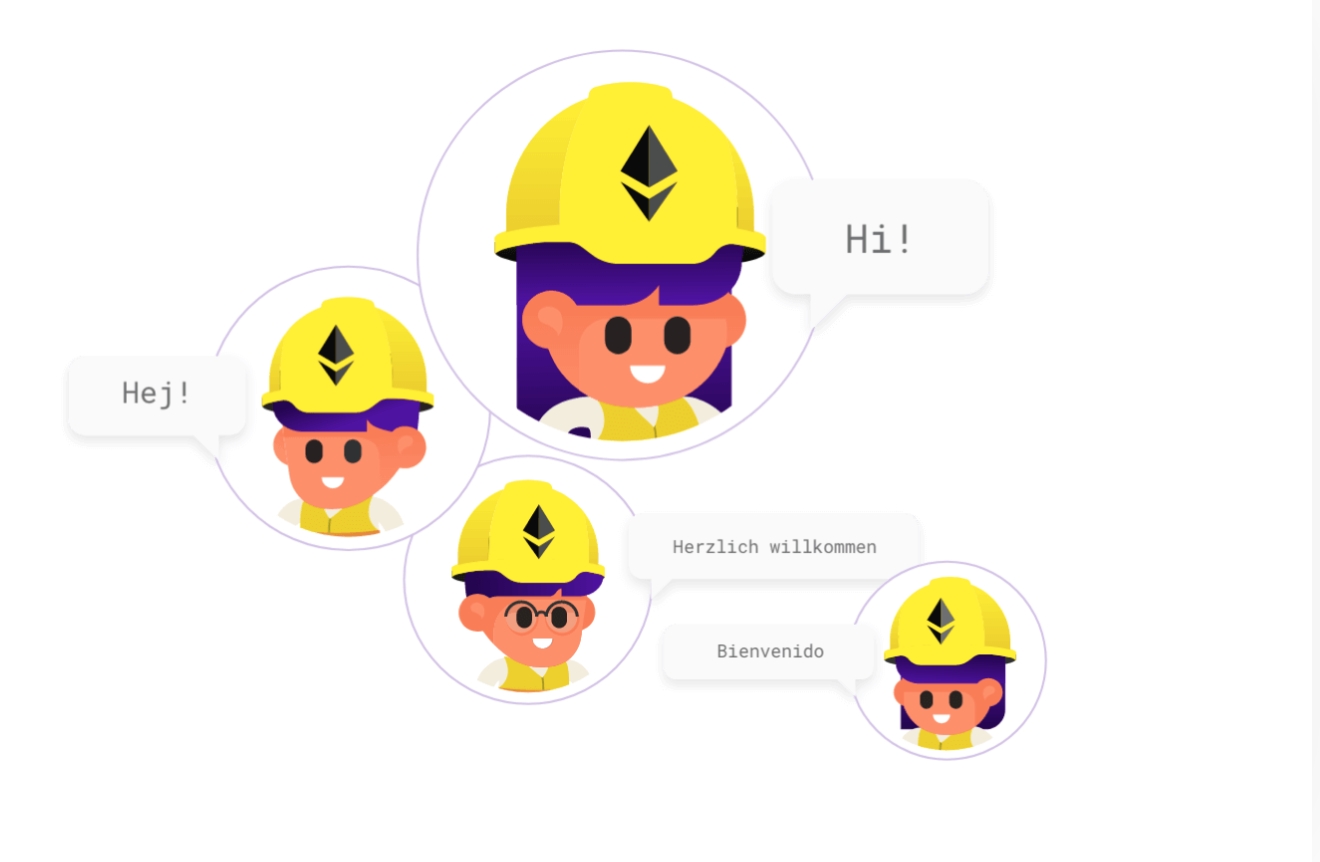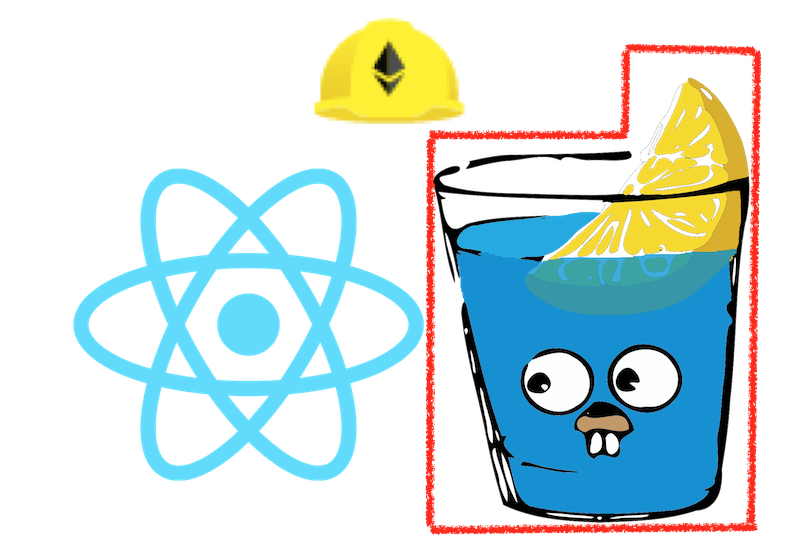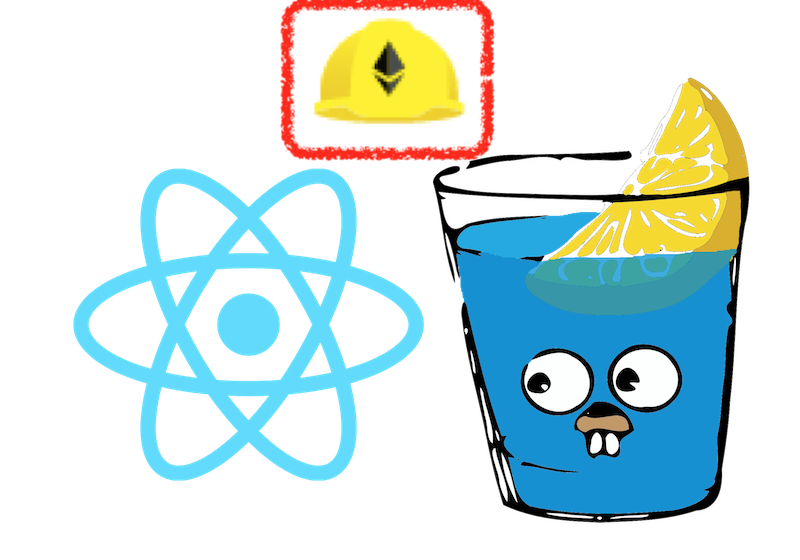Hardhat - Solidity and NFT - Part 2 - Deploy contract and Mint NFT
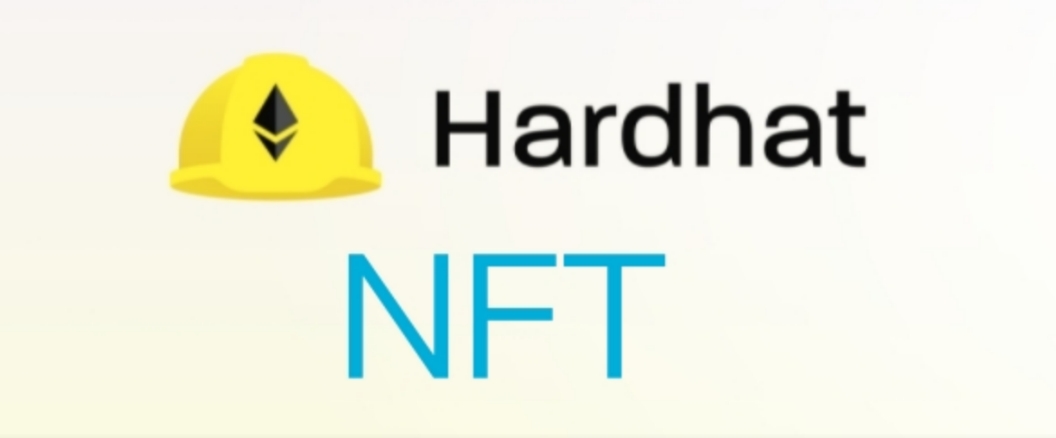
我們上一篇已經設定好docker及hardhat專案,這一篇就從NFT開始。
Generate NFT metadata
先建立一個images資料夾後,把你想要的圖片放進去,並存成1, 2, 3…之類的檔名,然後用ipfs-car指令打包在一起。
找不到圖可以先用opensea doc裡的圖當練習
接著到NFT Storage上傳images.car檔案就可以了。 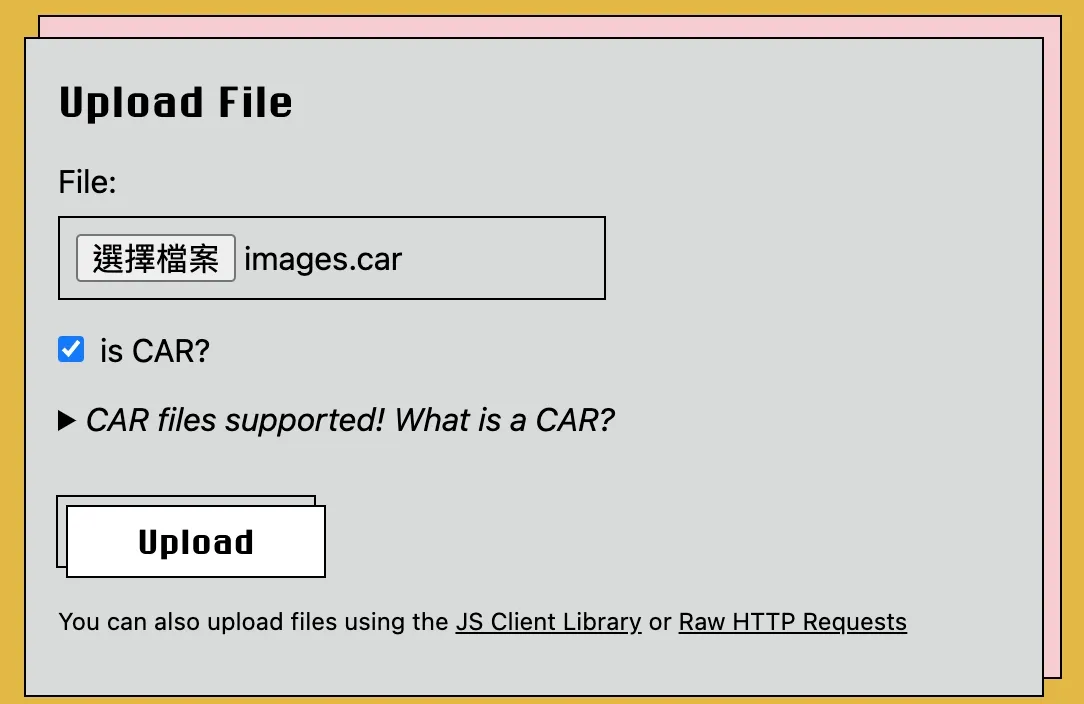
在NFT Storage點開剛剛上傳檔案,找到image url,等一下要塞到metadata裡的image欄位。 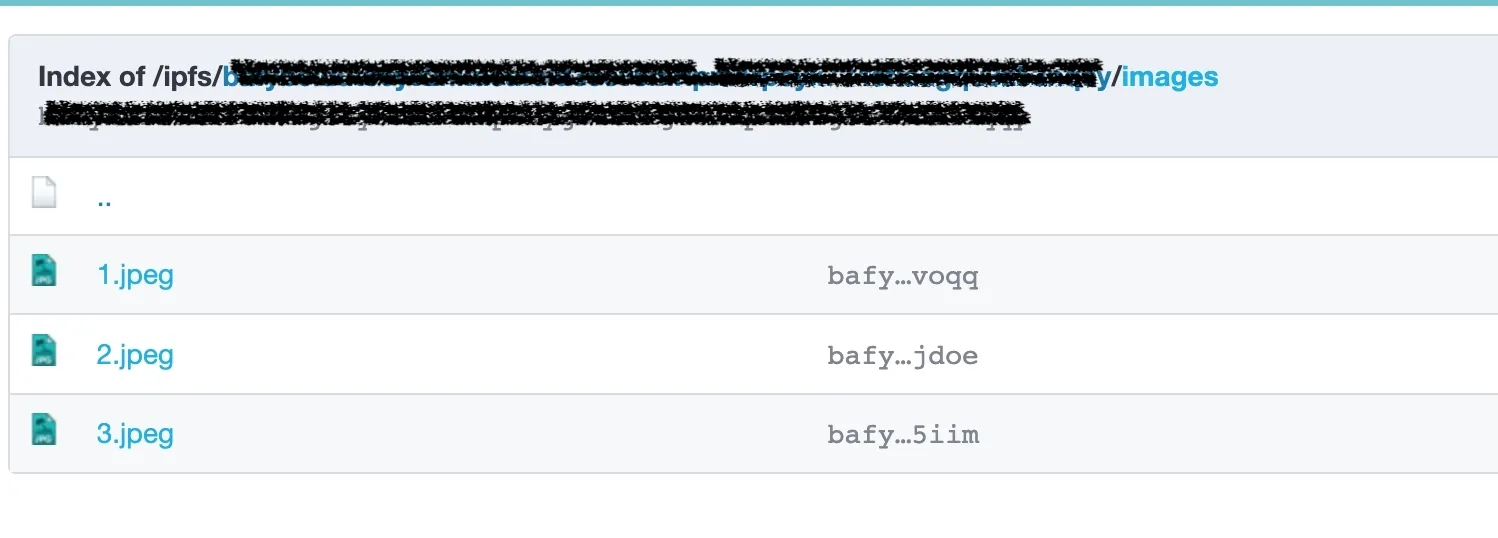
再來建立一個metadata資料夾,設計metadata json,每個metadata裡的資訊對應到每一張圖片,所以metadata資料夾裡會有3個json file,檔名則是單純的1, 2, 3,之後在solidity裡會對應到tokenId。
1
{
"description" : "This is my daughter's hand NFT.",
"external_url" : "https://example.com/?token_id=1",
"image" : <YOUR IPFS IMAGE 1.jpg>,
"name" : "Tearing off paper"
}2
{
"attributes" : [
{
"trait_type" : "level",
"value" : 3
},
{
"trait_type" : "stamina",
"value" : 11.7
},
{
"trait_type" : "personality",
"value" : "sleepy"
},
{
"display_type" : "boost_number",
"trait_type" : "aqua_power",
"value" : 30
},
{
"display_type" : "boost_percentage",
"trait_type" : "stamina_increase",
"value" : 15
},
{
"display_type" : "number",
"trait_type" : "generation",
"value" : 1
}
],
"description" : "This is my daughter's hand NFT.",
"external_url" : "https://example.com/?token_id=2",
"image" : <YOUR IPFS IMAGE 2.jpg>,
"name" : "Playing with building blocks"
}3
{
"description" : "This is my daughter's hand NFT.",
"external_url" : "https://example.com/?token_id=1",
"image" : <YOUR IPFS IMAGE 3.jpg>,
"name" : "Grabbing her dinner"
}其中有個
json裡有attributes,這資訊會顯示在Opensea上,詳細欄位可以在Opensea Docs上看到
然後一樣用car打包,上傳到NFTStorage 
在NFTStorage上就可以得到一個metadata url,要設定在solidity setBaseTokenUrl裡。 到這邊準備工作就告一個段落了,我們再來就要開始Coding了,分別要寫solidity跟typescript。
Start coding
Solidity
我們先來寫contract,在contract資料夾底下建立自己的solidity檔案。
contracts/BabyHands.sol
// SPDX-License-Identifier: MIT
pragma solidity ^0.8.4;
import "@openzeppelin/contracts/token/ERC721/ERC721.sol";
import "@openzeppelin/contracts/utils/Counters.sol";
import "@openzeppelin/contracts/access/Ownable.sol";
import "hardhat/console.sol";
contract BabyHands is ERC721, Ownable {
using Counters for Counters.Counter;
// Constants
uint256 public constant TOTAL_SUPPLY = 3;
uint256 public constant MINT_PRICE = 0.08 ether;
Counters.Counter private currentTokenId;
string public baseTokenURI;
constructor() ERC721("BabyHands", "BBH") {
baseTokenURI = "";
}
function mintTo(address recipient) public payable returns (uint256) {
uint256 tokenId = currentTokenId.current();
require(tokenId < TOTAL_SUPPLY, "Max supply reached");
require(msg.value == MINT_PRICE, "Mint price is not equal.");
currentTokenId.increment();
uint256 newItemId = currentTokenId.current();
_safeMint(recipient, newItemId);
return newItemId;
}
/// @dev Returns an URI for a given token ID
function _baseURI() internal view virtual override returns (string memory) {
return baseTokenURI;
}
/// @dev Sets the base token URI prefix.
function setBaseTokenURI(string memory _baseTokenURI) public onlyOwner {
baseTokenURI = _baseTokenURI;
}
}在contract裡,我們繼承了ERC721,然後開了mintTo, setBaseTokenURI兩個function,到時候會用hardhat的task去mint跟設定base URI。然後我們用hardhat compile去編譯我們的solidity。 
如果缺少**@openzeppelin/contracts**的話,可以先跑
docker-compose exec hardhat yarn add -D @openzeppelin/contracts
Typescript
再來用Typescript寫task,好讓我們可以透過hardhat cli操作部署上去的contract。
scripts/helpers.ts
import { getContractAt } from "@nomiclabs/hardhat-ethers/internal/helpers";
// Helper method for fetching environment variables from .env
function getEnvVariable(key: string, defaultValue?: string) {
if (process.env[key]) {
return process.env[key];
}
if (!defaultValue) {
throw `${key} is not defined and no default value was provided`;
}
return defaultValue;
}
// Helper method for fetching a connection provider to the Ethereum network
function getProvider(ethers: any) {
return ethers.getDefaultProvider(getEnvVariable("NETWORK", "rinkeby"), {
infura: getEnvVariable("INFURA_ID"),
});
}
// Helper method for fetching a wallet account using an environment variable for the PK
function getAccount(ethers: any) {
return new ethers.Wallet(getEnvVariable("PRIVATE_KEY") ?? "", getProvider(ethers));
}
// Helper method for fetching a contract instance at a given address
function getContract(contractName: string, hre: any) {
/*
// 如果你還不想發布到測試網路,可以用hardhat預設的account取代下面的getAccount()
const accounts = await hre.ethers.getSigners();
const account = accounts[0]
*/
const account = getAccount(hre.ethers);
return getContractAt(hre, contractName, getEnvVariable("NFT_CONTRACT_ADDRESS") ?? "", account);
}
export {
getContract,
}scripts/deploy.ts
import "@nomiclabs/hardhat-waffle";
import fetch from "node-fetch";
import { task } from "hardhat/config";
import { getContract } from "./helpers";
task("deploy", "Deploys the BabyHand.sol contract")
.setAction(async function (taskArguments, hre) {
const BabyHands = await hre.ethers.getContractFactory("BabyHands");
const babyHands = await BabyHands.deploy();
await babyHands.deployed();
console.log("BabyHands deployed to:", babyHands.address);
});
task("mint", "Mints from the NFT contract")
.addParam("address", "The address to receive a token")
.setAction(async function (taskArguments, hre) {
const contract = await getContract("BabyHands", hre);
const transactionResponse = await contract.mintTo(taskArguments.address, {
gasLimit: 500_000,
value: hre.ethers.utils.parseEther("0.08"),
});
console.log(`Transaction Hash: ${transactionResponse.hash}`);
});
task("set-base-token-uri", "Sets the base token URI for the deployed smart contract")
.addParam("baseUrl", "The base of the tokenURI endpoint to set")
.setAction(async function (taskArguments, hre) {
const contract = await getContract("BabyHands", hre);
const transactionResponse = await contract.setBaseTokenURI(
taskArguments.baseUrl,
{
gasLimit: 500_000,
}
);
console.log(`Transaction Hash: ${transactionResponse.hash}`);
});
task("token-uri", "Fetches the token metadata for the given token ID")
.addParam("tokenId", "The tokenID to fetch metadata for")
.setAction(async function (taskArguments, hre) {
const contract = await getContract("BabyHands", hre);
const response = await contract.tokenURI(taskArguments.tokenId, {
gasLimit: 500_000,
});
const metadata_url = response;
console.log(`Metadata URL: ${metadata_url}`);
const metadata = await fetch(metadata_url).then((res) => res.json());
console.log(
`Metadata fetch response: ${JSON.stringify(metadata, null, 2)}`
);
});然後回頭修改hardhat.config.ts檔案,載入deploy.ts,之後hardhat才能讀到我們寫的task
hardhat.config.ts
import * as dotenv from "dotenv";
import { HardhatUserConfig } from "hardhat/config";
import "@nomiclabs/hardhat-etherscan";
import "@nomiclabs/hardhat-waffle";
import "@typechain/hardhat";
import "hardhat-gas-reporter";
import "solidity-coverage";
dotenv.config();
import "./scripts/deploy.ts"; // <<<<<<< 新增這行
const config: HardhatUserConfig = {
solidity: "0.8.4",
networks: {
hardhat: { // <<<<<<<< 新增這段,如果想使用本地部署的話
forking: {
url: process.env.RINKEBY_URL || "",
}
},
rinkeby: {
url: process.env.RINKEBY_URL || "",
accounts:
process.env.PRIVATE_KEY !== undefined ? [process.env.PRIVATE_KEY] : [],
},
},
gasReporter: {
enabled: process.env.REPORT_GAS !== undefined,
currency: "USD",
},
etherscan: {
apiKey: {
rinkeby: process.env.ETHERSCAN_API_KEY,
},
},
};
export default config;我們會先deploy,然後會得到一個address,再把env裡新增一個NFT_CONTRACT_ADDRESS給helpers.ts用。
只要你rinkeby測試網路的錢包有ETH,就可以都改成
--network rinkeby操作
我這邊用的account是hardhat提供的Account #19,所以
mintaddress跟env裡的PRIVATE_KEY都是拿Account #19的資訊
操作都正常以後,我們就可以上opensea看mint到的NFT了。我rinkeby測試網路的在這裡 > BabyHands
最後呢,如果要你的Etherscan contract可以看到solidity code,只要多跑一個指令就行:
docker-compose exec hardhat npx hardhat verify 0x23E4673d7B7F494b328A967B60Daa58E2D19a947 "BabyHands" "BBH" --contract contracts/BabyHands.sol:BabyHands --network rinkeby
好囉,看到你的NFT的,要更深入研究可以多看opensea其他項目的合約,可以有更多變化。
References:

